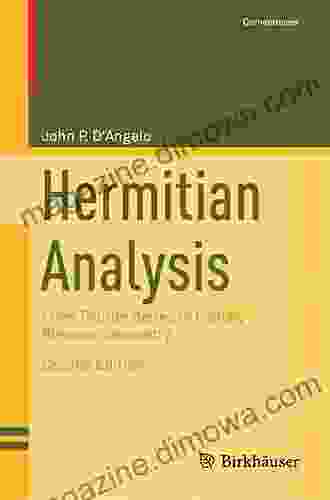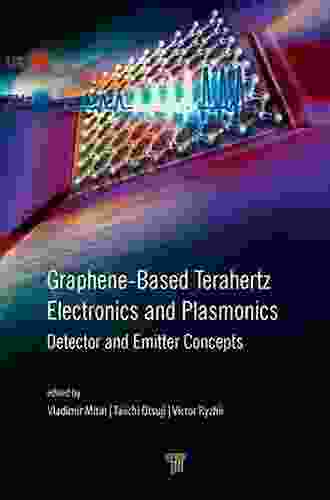Detector and Emitter Concepts: Unveiling the Principles and Applications of Detection and Emission Technologies

4.6 out of 5
| Language | : | English |
| File size | : | 84422 KB |
| Text-to-Speech | : | Enabled |
| Enhanced typesetting | : | Enabled |
| Print length | : | 998 pages |
| Screen Reader | : | Supported |
In the realm of science and technology, the concepts of detection and emission play a pivotal role. Detectors enable us to sense and measure various forms of energy, while emitters facilitate the generation and release of energy. From medical imaging to telecommunications, detector and emitter technologies find widespread applications, shaping our understanding of the world around us.
Detector Concepts
Detectors are devices designed to sense and convert physical stimuli into measurable electrical signals. The principles underlying detector operation are diverse and depend on the specific type of stimulus being detected.
Radiation Detectors
Radiation detectors play a crucial role in nuclear physics, medical imaging, and environmental monitoring. They convert ionizing radiation, such as gamma rays and X-rays, into electrical signals. Common examples include Geiger-Müller counters and scintillation detectors.
Light Detectors
Light detectors, also known as photodetectors, are essential for optical communication, imaging, and spectroscopy. They respond to light energy and generate electrical signals proportional to the intensity and wavelength of the incoming light. Photodiodes and photomultipliers are widely used light detectors.
Chemical Detectors
Chemical detectors are employed in various fields, including environmental monitoring, manufacturing, and security. They detect and identify chemical species based on their specific properties, such as chemical composition or molecular structure. Gas chromatography and mass spectrometry are commonly used chemical detection techniques.
Emitter Concepts
Emitters are devices designed to generate and release energy in a controlled manner. They find applications in lighting, communication, and medical therapy.
Light Emitters
Light emitters, such as LEDs (light-emitting diodes),lasers, and incandescent bulbs, produce light energy through electrical stimulation or chemical reactions. They are used in a wide range of applications, from general lighting to fiber optic communication.
Radiation Emitters
Radiation emitters, such as X-ray tubes and particle accelerators, generate ionizing radiation. They are used in medical imaging, cancer therapy, and scientific research.
Energy Emitters
Energy emitters release energy in various forms, such as heat, microwaves, and ultrasound. Electric heating elements, microwave ovens, and medical ultrasound transducers are examples of energy emitters.
Applications of Detector and Emitter Technologies
The applications of detector and emitter technologies are vast and impact numerous disciplines:
Medical Imaging
Radiation detectors and light emitters play a crucial role in medical imaging techniques such as X-ray radiography, computed tomography (CT scans),and magnetic resonance imaging (MRI). These technologies allow physicians to visualize internal structures and diagnose various medical conditions.
Telecommunications
Light detectors and light emitters form the backbone of modern optical communication systems. They enable high-speed data transmission over fiber optic cables, revolutionizing the way we communicate and access information.
Industrial Automation
Detectors and emitters are used in industrial automation to monitor and control various processes. Light detectors are employed in barcode scanners and optical sensors, while radiation detectors are used in safety systems and environmental monitoring.
Scientific Research
Detector and emitter technologies are essential in scientific research across various disciplines. They enable the detection and measurement of various physical phenomena, providing valuable insights into the fundamental nature of the universe.
Advancements in Detector and Emitter Technologies
Research and development in detector and emitter technologies are constantly pushing the boundaries of scientific innovation. Some of the cutting-edge advancements include:
Quantum Detectors
Quantum detectors, such as superconducting tunnel junctions (STJs),offer unprecedented sensitivity and energy resolution, enabling the detection of extremely weak signals. These detectors have applications in astrophysics, particle physics, and medical imaging.
Nano-Emitters
Nano-emitters, such as quantum dots and carbon nanotubes, exhibit novel optical properties and are being explored for applications in high-efficiency lighting, displays, and sensors.
Bio-Emitters
Bio-emitters, such as genetically modified bacteria or fireflies, are engineered to emit light or other forms of energy for biomedical imaging, environmental monitoring, and biosensing.
Detector and emitter concepts form the foundation of numerous technologies that shape our modern world. By understanding the principles, applications, and advancements in these technologies, we empower ourselves to leverage their potential for scientific discovery, technological innovation, and societal progress. From medical imaging to telecommunications, detector and emitter technologies continue to revolutionize various fields, promising exciting possibilities for the future.
Image Alt Attributes:
- X-ray machine: Radiation emitter used in medical imaging
- Fiber optic cable: Light emitter used in telecommunication
- Barcode scanner: Light detector used in industrial automation
- Quantum dot: Nano-emitter with applications in lighting and displays
- Bio-emitter bacteria: Genetically modified organism used for biosensing
4.6 out of 5
| Language | : | English |
| File size | : | 84422 KB |
| Text-to-Speech | : | Enabled |
| Enhanced typesetting | : | Enabled |
| Print length | : | 998 pages |
| Screen Reader | : | Supported |
Do you want to contribute by writing guest posts on this blog?
Please contact us and send us a resume of previous articles that you have written.
 Book
Book Novel
Novel Page
Page Chapter
Chapter Text
Text Story
Story Genre
Genre Reader
Reader Library
Library Paperback
Paperback E-book
E-book Magazine
Magazine Newspaper
Newspaper Paragraph
Paragraph Sentence
Sentence Bookmark
Bookmark Shelf
Shelf Glossary
Glossary Bibliography
Bibliography Foreword
Foreword Preface
Preface Synopsis
Synopsis Annotation
Annotation Footnote
Footnote Manuscript
Manuscript Scroll
Scroll Codex
Codex Tome
Tome Bestseller
Bestseller Classics
Classics Library card
Library card Narrative
Narrative Biography
Biography Autobiography
Autobiography Memoir
Memoir Reference
Reference Encyclopedia
Encyclopedia Swati Gupta
Swati Gupta John Cooper
John Cooper John J Rooney
John J Rooney Joan Sweeney
Joan Sweeney John Moody
John Moody Richard Seff
Richard Seff Jim Woodring
Jim Woodring John Florio
John Florio John Milton
John Milton Jim Lupkin
Jim Lupkin John Cote
John Cote John Biggar
John Biggar Lexie Barnes
Lexie Barnes Jimmy Sanderson
Jimmy Sanderson Jim Noles
Jim Noles Michael Wynn
Michael Wynn Joe Putignano
Joe Putignano Joel S Cohen
Joel S Cohen Joe Gisondi
Joe Gisondi Samit Roy
Samit Roy
Light bulbAdvertise smarter! Our strategic ad space ensures maximum exposure. Reserve your spot today!

 Richard WrightThe Andes Guide For Climbers And Skiers: Your Gateway to Majestic Peaks and...
Richard WrightThe Andes Guide For Climbers And Skiers: Your Gateway to Majestic Peaks and...
 Rudyard KiplingThe Single Girl's Guide to Lisbon: A Journey of Self-Discovery and Adventure
Rudyard KiplingThe Single Girl's Guide to Lisbon: A Journey of Self-Discovery and Adventure
 Vince HayesThe Art of Discovering Whales: A Captivating Journey into the Realm of Gentle...
Vince HayesThe Art of Discovering Whales: A Captivating Journey into the Realm of Gentle... Eugene ScottFollow ·3.3k
Eugene ScottFollow ·3.3k E.E. CummingsFollow ·10.6k
E.E. CummingsFollow ·10.6k Bradley DixonFollow ·9k
Bradley DixonFollow ·9k Milan KunderaFollow ·11.6k
Milan KunderaFollow ·11.6k Howard PowellFollow ·6.1k
Howard PowellFollow ·6.1k Corbin PowellFollow ·14.6k
Corbin PowellFollow ·14.6k Bobby HowardFollow ·19.2k
Bobby HowardFollow ·19.2k Evan SimmonsFollow ·7.9k
Evan SimmonsFollow ·7.9k

 Joshua Reed
Joshua ReedTake Your Marketing Business Into The Next Level
Are you ready to...

 Aaron Brooks
Aaron BrooksFrom Fourier to Cauchy-Riemann: Geometry Cornerstones
From Fourier to Cauchy-Riemann: Geometry...

 Orson Scott Card
Orson Scott CardUnveiling the Art of Mitigation Banking: A Comprehensive...
In the intricate dance between...

 Victor Hugo
Victor HugoUnleash Your Creativity: A Journey Through the Enchanting...
Prepare to be captivated as we...

 Duncan Cox
Duncan CoxLoad of Bull: An Englishman's Adventures in Madrid
By Simon Bunce ...
4.6 out of 5
| Language | : | English |
| File size | : | 84422 KB |
| Text-to-Speech | : | Enabled |
| Enhanced typesetting | : | Enabled |
| Print length | : | 998 pages |
| Screen Reader | : | Supported |








